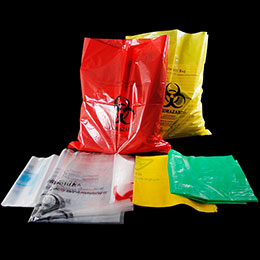Some wastes have the ability to harm humans and the environment. Therefore, containing them becomes a priority for everyone. These hazardous substances are known as biohazardous waste and are commonly found in clinical laboratories, healthcare facilities, pharmaceutical industries and research facilities. The containers used to seal biohazardous waste are called
biohazard bags.

What is a biohazard bag?
The name itself is a self-explanatory term that emphasizes the word "biohazard". The need to collect, seal and dispose of toxic waste has been articulated by all scientists, health workers and environmentalists. As a result, these contaminants are collected in a special type of bag called a biohazard bag, which consists of high-density polyethylene, polypropylene, plastic and polyethylene.
These bags are popular in all medical sectors, especially during the Covid-19 pandemic. Demand for biohazard bags used to distinguish waste from coronavirus-infected patients has increased significantly over the past seven months. According to a report published by Research Dive, the global biohazard bag market will exceed $469.1 million by 2027, as its use is increasing in all healthcare facilities.
Commonly used
biohazard bags:
There are different types of bags used to contain different types of biohazardous materials. Important biohazard bags preferred by all sectors handling hazardous waste are as follows:
These types of bags are typically used to segregate toxic materials from uncontaminated materials. The red biohazard bags are used to collect pathological waste and only collect objects with blood on them. The contaminants usually included are anatomical wastes and body fluids such as semen, tissues, saliva, animal carcasses and organs. In addition to this, blood-soaked clothing, specimen swabs, toxic medical equipment, and infected gloves are also collected and sealed in these biohazard bags.
Avoid placing wastes such as alcohol, chemicals, solvents, lead, radioactive wastes, food packaging and pharmaceutical wastewater in the red biohazard bags, as they are not designed to handle these wastes.
These bags are used to handle chemicals, infectious clinical materials and pharmaceuticals. In addition, dressings, swabs, paper towels, aprons, soiled gloves, diapers and sanitary napkins are also collected and placed in the yellow biohazard bags. Other less common items, such as IV tubing, infusion bags, syringes and metal parts, are also part of the biohazard waste that goes into these bags.
Anatomical waste, placental residue, pathological waste, household waste and non-infectious waste are not included in the yellow biohazard bags.
Autoclave biohazard bags:
These bags include red, yellow and clear colors to help distinguish the type of waste in each bag.
Autoclave biohazard bags consist of the following special features:
They are rupture and tear resistant under normal conditions.
These bags are printed with the biohazard symbol.
We can also provide customized service, please let us know your requirements.
More Tianbai can offer please check here,
chnpack.com.
If you have RFQ, please do not hesitate to send mail to
inquiry@chnpack.com.

